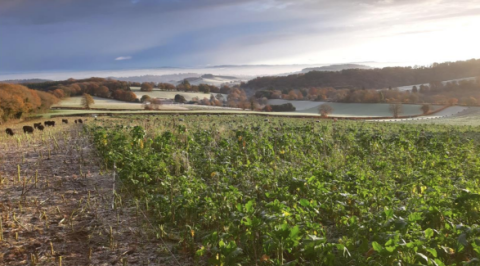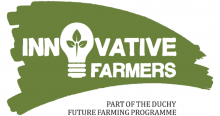Download the Final Report from this trial at the bottom of the page.
The benefits
A diverse fodder mix can:
- Improve soil health and biodiversity by creating habitats for organisms above and below ground.
- Provide year-round ground cover to protect the soil from run off in heavy rain.
- Create a source of suitable nutrition for outwintering animals and reduce the need to supplement their diet with sources of fibre like hay, creating a substantial cost saving.
- Reduce the need for artificial nitrogen inputs by encouraging plants that fix nutrients into the soil.
Trial Design
The field lab will establish trials on 4 farms which will compare a diverse forage mixture with the farm’s “normal” mono-crop forage brassica / fodder beet. Animals will be introduced at a suitable time and stocking rate for appropriate management of the crop.
The following parameters will be measured to assess the differences and data collected for analysis:
How suitable plant species and diverse varieties are for winter grazing in terms of:
- Maintain green leaf area and ground cover (year-round).
- Provide suitable nutrition to animals for rumination and to maintain or increase DLWG (compared to current options)
Measuring change in soil structure:
- Differences in water infiltration rates
- VESS
- Assess surface run-off
- Measure cultivation required (for following crop)
Farm economics / cost reduction (compared to traditional wintering systems) by:
- Differences in use of artificial nitrogen (for forage crop &/or following crop/ley)
- Differences in cultivation effort (establishment, maintenance and following crop/ley establishment)
- Differences in use of synthetic chemicals (g/active)
- Farmers to weigh animals and condition score breeding animals prior and post removal from crop
Biodiversity Outcomes:
- Monitoring of biodiversity above and below ground (worms, birds & insects)
Species selected and purpose
|
Species |
% |
Functional Group |
Description |
|
White Clover |
2.9 |
Legume |
Low growing, high protein content, minerals, digestibility, persistence, waterlogging tolerance, good relative yield |
|
Berseem Clover |
1.1 |
Legume |
Annual, fast growing, large biomass, least hardy, soil fertility |
|
Crimson Closer |
1 |
Legume |
Annual, soil fertility |
|
Alsike Clover |
1 |
Legume |
Perennial, slower growing than red clover, Good for heavy and acid soils, frost tolerant |
|
Hairy Vetch |
16 |
Legume |
Out competes weeds, fixes N, improves soil structure |
|
Linseed |
5.31 |
Forb |
Annual, bird feed, improves soil structure |
|
Forage Rape |
2.1 |
Brassica |
Palatable, high yield, protein rich |
|
Kale Seed R/C |
1.9 |
Brassica |
Highest yielding brassica, winter hardy, high protein |
|
Kale x Rape Hybrid R/C |
0.45 |
Brassica |
Quick establishment, winter hardy, high protein |
|
Attila Diploid Italian Ryegrass |
25.7 |
Grass |
Short lived, high yielding, |
|
Spadona Perennial Chicory |
0.4 |
Herb |
Protein, Minerals, digestibility, good yield, anthelmintic, drought and frost tolerance |
|
Ribwort Plantain |
0.8 |
Herb |
Protein, Minerals, good relative yield, anthelmintic, waterlogging tolerance, marginal soil, drought |
|
C2 Canyon Spring Oats |
28.6 |
Grass |
Soil improving, can be allelopathic, grows on less fertile soils |
|
Daikon Tillage Radish |
5.7 |
Brassica |
Deep rooted, improves soil structure, competes with weeds |
|
Iregi Sunflower Seed |
6.2 |
Forb |
Strong roots break up compacted soils, seeds for farmland birds |
|
White Millet Seed |
0.84 |
Grass |
Bird seed |
|
Functional Groups |
% Composition |
||
|
Brassica |
10.15 |
||
|
Grass |
55.14 |
||
|
Herb |
1.20 |
||
|
Legume |
22.00 |
||
|
Forb |
11.51 |
||
|
Grand Total |
100.00 |
||



